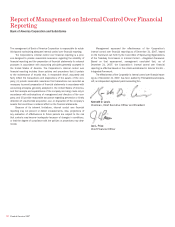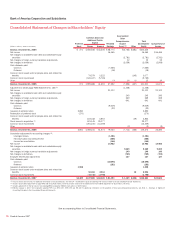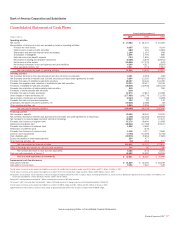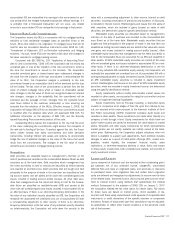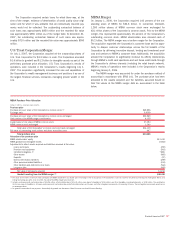Bank of America 2007 Annual Report Download - page 121
Download and view the complete annual report
Please find page 121 of the 2007 Bank of America annual report below. You can navigate through the pages in the report by either clicking on the pages listed below, or by using the keyword search tool below to find specific information within the annual report.ration accounted for this tax benefit as a reduction to income tax expense.
The adoption of EITF 06-11 will not have a material impact on the Corpo-
ration’s financial condition and results of operations.
Effective January 1, 2007, the Corporation adopted SFAS No. 157,
“Fair Value Measurements” (SFAS 157) and SFAS No. 159 “The Fair Value
Option for Financial Assets and Financial Liabilities” (SFAS 159). SFAS
157 defines fair value, establishes a framework for measuring fair value
under GAAP and enhances disclosures about fair value measurements.
Fair value is defined under SFAS 157 as the exchange price that would be
received for an asset or paid to transfer a liability (an exit price) in the
principal or most advantageous market for the asset or liability in an
orderly transaction between market participants on the measurement
date. SFAS 159 allows an entity the irrevocable option to elect fair value
for the initial and subsequent measurement for certain financial assets
and liabilities on a contract-by-contract basis. The impact of adopting both
SFAS 157 and SFAS 159 reduced the beginning balance of retained earn-
ings as of January 1, 2007 by $208 million, net-of-tax. Subsequent
changes in fair value of these financial assets and liabilities are recog-
nized in earnings when they occur. For additional information on the fair
value of certain financial assets and liabilities, see the Fair Value section
of this note and Note 19 – Fair Value Disclosures to the Consolidated
Financial Statements.
Effective January 1, 2007, the Corporation adopted FASB Staff Posi-
tion (FSP) No. FAS 13-2, “Accounting for a Change or Projected Change in
the Timing of Cash Flows Relating to Income Taxes Generated by a Lever-
aged Lease Transaction” (FSP 13-2). The principal provision of FSP 13-2 is
the requirement that a lessor recalculate the recognition of lease income
when there is a change in the estimated timing of the cash flows relating
to income taxes generated by such leveraged lease. The adoption of FSP
13-2 reduced the beginning balance of retained earnings as of January 1,
2007 by $1.4 billion, net-of-tax, with a corresponding offset decreasing the
net investment in leveraged leases recorded as part of loans and leases.
Following the adoption, if during the remainder of the lease term the timing
of the income tax cash flows generated by the leveraged leases are
revised as a result of final determination by the Internal Revenue Service
(IRS) on certain leveraged leases or management changes its assumption
about the timing of the tax cash flows, the rate of return shall be recalcu-
lated from the inception of the lease using the revised assumption and the
change in the net investment shall be recognized as a gain or loss in the
year in which the assumption is changed.
Effective January 1, 2007, the Corporation adopted FASB Inter-
pretation No. 48, “Accounting for Uncertainty in Income Taxes, an inter-
pretation of FASB Statement No. 109” (FIN 48). FIN 48 clarifies the
accounting and reporting for income taxes where interpretation of the tax
law may be uncertain. FIN 48 prescribes a comprehensive model for the
financial statement recognition, measurement, presentation and dis-
closure of income tax uncertainties with respect to positions taken or
expected to be taken in income tax returns. The adoption of FIN 48
reduced the beginning balance of retained earnings as of January 1, 2007
by $146 million and increased goodwill by $52 million. For additional
information on income taxes, see Note 18 – Income Taxes to the Con-
solidated Financial Statements.
Cash and Cash Equivalents
Cash on hand, cash items in the process of collection, and amounts due
from correspondent banks and the Federal Reserve Bank are included in
cash and cash equivalents.
Securities Purchased Under Agreements to Resell
and Securities Sold under Agreements to Repurchase
Securities purchased under agreements to resell and securities sold under
agreements to repurchase are treated as collateralized financing trans-
actions. These agreements are recorded at the amounts at which the
securities were acquired or sold plus accrued interest, except for certain
structured reverse repurchase agreements for which the Corporation has
elected the fair value option. For more information on structured reverse
repurchase agreements for which the Corporation has elected the fair
value option, see Note 19 – Fair Value Disclosures to the Consolidated
Financial Statements. The Corporation’s policy is to obtain the use of
securities purchased under agreements to resell. The market value of the
underlying securities, including accrued interest, which collateralize the
related receivable on agreements to resell, is monitored. The Corporation
may require counterparties to deposit additional collateral or return collat-
eral pledged, when appropriate.
Collateral
The Corporation accepts collateral that it is permitted by contract or custom
to sell or repledge. At December 31, 2007, the fair value of this collateral
was approximately $210.7 billion of which $156.3 billion was sold or
repledged. At December 31, 2006, the fair value of this collateral was
approximately $186.6 billion of which $113.0 billion was sold or repledged.
The primary source of this collateral is reverse repurchase agreements. The
Corporation also pledges securities and loans as collateral in transactions
that include repurchase agreements, public and trust deposits, Treasury tax
and loan notes, and other short-term borrowings. This collateral can be sold
or repledged by the counterparties to the transactions.
In addition, the Corporation obtains collateral in connection with its
derivative activities. Required collateral levels vary depending on the credit
risk rating and the type of counterparty. Generally, the Corporation accepts
collateral in the form of cash, U.S. Treasury securities and other market-
able securities. Based on provisions contained in legal netting agree-
ments, the Corporation has netted cash collateral against the applicable
derivative mark-to-market exposures. Accordingly, the Corporation offsets
its obligation to return or its right to reclaim cash collateral against the fair
value of the derivatives being collateralized. The Corporation also pledges
collateral on its own derivative positions which can be applied against
derivative liabilities.
Trading Instruments
Financial instruments utilized in trading activities are stated at fair value.
Fair value is generally based on quoted market prices or quoted market
prices for similar assets and liabilities. If these market prices are not
available, fair values are estimated based on dealer quotes, pricing mod-
els, discounted cash flow methodologies, or similar techniques for which
the determination of fair value may require significant management judg-
ment or estimation. Realized and unrealized gains and losses are recog-
nized in trading account profits (losses).
Derivatives and Hedging Activities
The Corporation designates a derivative as held for trading, an economic
hedge not designated as a SFAS No. 133, “Accounting for Derivative
Instruments and Hedging Activities, as amended” (SFAS 133) hedge, or a
qualifying SFAS 133 hedge when it enters into the derivative contract. The
designation may change based upon management’s reassessment or
changing circumstances. Derivatives utilized by the Corporation include
swaps, financial futures and forward settlement contracts, and option
contracts. A swap agreement is a contract between two parties to
Bank of America 2007
119





